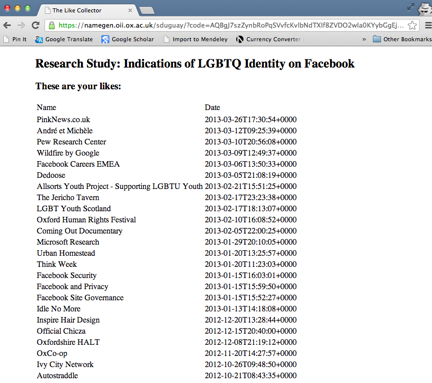What is it?
This small pilot project was linked to my larger thesis, which looked at the choices and experiences of individuals identifying as LGBTQ (lesbian, gay, bisexual, transgender, queer, or other diverse sexual or gender orientations) related to expressing this part of their identity on Facebook. This smaller project compared individuals’ perceptions of identity expression with actual indications of identity on their Facebook profiles.
Why is it interesting?
Overall, this research aimed to uncover something about the way that people manage different aspects of their identities for different audiences across their Facebook networks. This ties into broader research about privacy policies on sites like Facebook as well as practical knowledge about what may or may not be working in terms of privacy settings and online social norms. Specifically for LGBTQ people, the research findings could be relevant to organizations wishing to reach out to this community using Facebook groups or pages. It may also be important in terms of keeping people safe if there are parts of their identity they do not want exposed to certain people due to threats of bullying or discrimination.
What did you find?
Given that this was a pilot project, the study focused more on the development and limitations of new methods. I created a Facebook application (PHP code located here) that was somewhat unstable but collected the “Likes” of 7 participants. After analyzing 499 Likes for indications of LGBTQ identity and comparing these to survey responses, here is the abstract from the paper I submitted for my Digital Social Research course at the Oxford Internet Institute:
Indications of LGBTQ identity on Facebook: Use of digital methods to compare perceived and actual identity performances
This paper seeks to examine the feasibility of specific digital social research methods in application to research comparing social networking site (SNS) users’ perceptions of their information sharing with their actual identity displays. To achieve this, the pilot project focuses on LGBTQ individuals and indicators of their gender or sexual identity present in their Facebook Likes. Participants were asked to complete a survey about their information sharing practices and to run a Facebook application to collect their Likes. Findings demonstrated some discrepancies between users’ perceptions and indications of LGBTQ identity in their Likes, which may indicate a reduced capacity for impression management on SNSs. These findings pave the way for further research regarding user intentionality in identity display, identity performance through Facebook’s other features, and the varying ways that individuals can indicate LGBTQ identity. This project also showed that although digital social research methods raise challenges in terms of distributed control over the research process, the complexity of developing analytical techniques, and removal of data from its online context, they are essential to accessing digital data in order for researchers to investigate social environments with no offline equivalent.
Keywords: digital social research, data accessibility, social networking sites, identity performance, context collapse, impression management
Tl;dr: There might be a difference between what users think they disclose on Facebook what is actually indicated on their profile. Although current digital methods pose many challenges to making these comparisons, they might be the best approach we have right now.
Please feel free to contact me if you’d like to read the whole paper or to discuss this topic further. Below are some screenshots from my no-frills Facebook app!
The front page:
A test-run using my Facebook Likes:
(Collecting the date was important to see if it reflected changes in information sharing over time, such as caring less what your Likes say about you the longer you are on Facebook)

